Hurricanes Erin and Opal swept across the Florida Panhandle in 1995 bringing with them sustained winds of 85 and 125 mph. In two surveys immediately following the hurricanes, 25 neighborhoods were inventoried for tree damage. This circular summarizes the results of our surveys and ranks the wind resistance of the North Florida tree species in these communities. Hurricane-susceptible communities should consider wind resistance as one of their criteria in tree species selection.
Introduction
When hurricanes strike land, along with damage to property such as houses, power lines, and commercial buildings, they may cause damage to trees in the urban forest. Yet, sometimes a fallen tree may be side-by-side with one which is standing and appears unaffected by the winds. This varied wind resistance by different trees may be due to many factors such as tree age, size, health, and species.
In 1995 two hurricanes impacted the Florida Panhandle. The first, on August 3, was Erin, a slow-moving hurricane which struck the Pensacola area with sustained winds of 85 mph. Two months later, on October 4, Opal moved through the Ft. Walton Beach area more quickly and had sustained winds of 125 mph. Three days after each hurricane we surveyed the damage to trees in neighborhoods where the eye of the hurricane had passed.
Methods
After Hurricane Erin, 12 neighborhoods in the Pensacola area—and after Hurricane Opal—Not enough urban data10 neighborhoods near Ft. Walton Beach were inventoried for tree damage Figure 1.
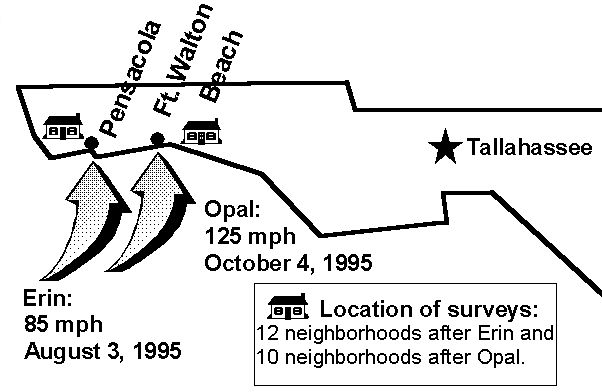
All trees along the neighborhood transects were observed and the following information was recorded:
- Has the tree fallen?
- If the tree fell, was it uprooted—or broken at the main stem?
- If the tree fell, did the tree cause damage to property and if so, what kind of damage?
- If the tree was still standing, did it have crown damage?
Results
What tree species fell?
Erin and Opal. Observations were obtained for 2,443 trees after Hurricane Erin and 2,468 trees after Hurricane Opal. Of the 4,911 surveyed trees, 11% fell in Erin and 13% as a result of Opal. Results are presented for 17 species which had a sample size greater than 14 trees in each hurricane. All except one species—Chinese tallow or popcorn tree Sapium sebiferum—were native to Florida.
Of the conifer species affected by both hurricanes, sand pine Pinus clausa exhibited poor wind resistance with only 61% and 58% standing after these two hurricanes, see Figures 2a, 2b, 2c, and 3.
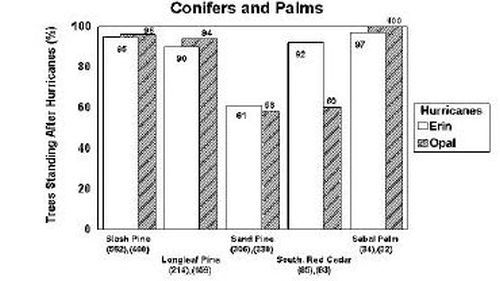
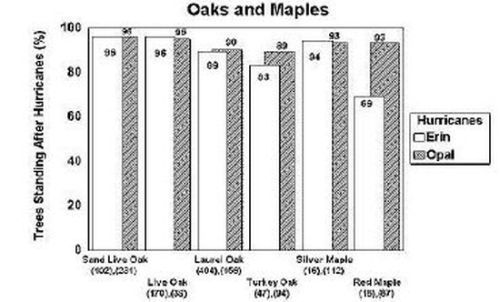
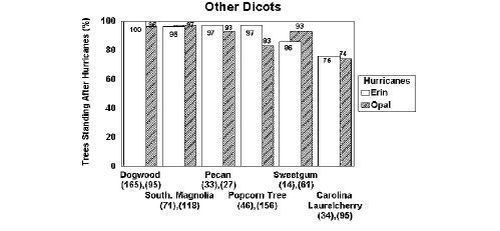
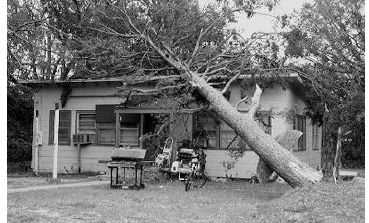
Note: in Figures 2a-2c, numbers in parentheses denote the number of trees observed in Erin and Opal, respectively.
Of the conifer species affected by both hurricanes, slash (Pinus elliottii var. elliottii) and longleaf (Pinus palustris) pines survived the winds best Figure 2a.
Southern red cedar Juniperus silicicola was one of two species damaged inconsistently during the two hurricanes: 92% were still standing after Erin compared to 60% after Opal Figure 2a.
Sabal palm Sabal palmetto was one of the most wind resistant species with 97% and 100% standing after the hurricanes; actually, the one sabal palm that was recorded as fallen was knocked over by another falling tree Figure 2a.
Of the oaks and maples, sand live oak Quercus geminata, live oak Quercus virginiana and silver maple Quercus saccharinum did the best with laurel oak Quercus laurifolia, turkey oak Quercus laevis, and red maple Acer rubrum comprising a less wind resistant group Figure 2b. Of the other dicot (broadleaf) trees, dogwood Cornus florida, magnolia Magnolia grandiflora, and pecan Carya illinoensis survived the hurricane best while Chinese tallow and sweetgum Liquidambar styraciflua comprised a second group and Carolina laurelcherry Prunus caroliniana held up poorly to the winds Figure 2c.
Five species were sampled in only one of the two hurricanes and so the results are preliminary for:
pignut hickory (Carya glabra), 100%;
pindo palm (Butia capitata), 97%;
sweet bay (Magnolia virginiana), 97%;
sycamore (Platanus occidentalis), 92%; and
loblolly pine (Pinus taeda)—82% still standing after one of the hurricanes.
Results from Other Hurricanes. After Hurricane Camille (1969) forestland trees were ranked for their wind resistance and live oak was at the top of the list 6, 7. Live oak also did well in our study and after Hurricane Andrew 2. Sabal palm was the second most wind-resistant tree in Hurricane Camille and the only tree that was "immune to hurricane-force winds" of Hugo in 1989 3, 6, 7. Both live oak and sabal palm survived the 145 mph winds of Andrew and then did well in this study after Erin and Opal 2. Pecan was reported as the least wind-resistant tree species during Hurricane Camille 6,7, yet in this study it survived the winds well. Three possible explanations for this different ranking could be:
1) Pecan is more exposed in orchards compared to neighborhoods; 2) Pecan does not tolerate winds greater than Erin and Opal; or 3) Our sample was too small (60 trees). Homeowners should be aware that pecan in urban settings may not be tolerant to stronger winds.
In forests during Camille 6,7, dogwood was reported to be more easily uprooted, yet in our study in neighborhoods 100% and 96% of the dogwoods were still standing.
Southern Pines:
Over the years, hurricanes such as Camille, Frederick, Hugo and Andrew have helped people observe effects of hurricane-force winds on southern pines in forests and urban areas. Pines have most often been placed relatively low on hurricane-resistance lists due to their propensity for stem breakage 1, 2, 6, 7.
Hurricane damage to pine trees can also initiate outbreaks of pests such as bark beetles, ambrosia beetles, sawyers, and blue stain fungi that preferentially attack stem-damaged pines.
Example: After Hurricane Andrew in 1992, many individual pines did not show immediate damage but died during the following year.
Therefore, even though high percentages of slash and longleaf pines were standing after Hurricanes Erin and Opal, their ability to survive hurricane level stresses may be less than other species with the same percentage of trees still standing.
How did trees fall?
When trees fell, they were either uprooted or broken at the trunk Table 1. Uprooting was the most common type of failure for slash and sand pines—while longleaf pine exhibited both kinds of damage—and southern red cedar most often broke off at the main stem. Laurel oak was uprooted as compared to Chinese tallow which has a weak stem that snapped in two in the strong winds.
Crown Damage
Some species, still standing after the hurricanes, exhibited crown damage. Crown damage was defined as greater than 50% of the branches in the crown broken. Southern pines, oaks, palms, and dogwood all had little crown damage (less than 2% of the trees). Magnolia, pecan, red maple and Chinese tallow were in the next group with some damage (less than 10%) in one of the hurricanes Table 2.
The most crown damage appeared on Southern red cedar, sycamore, silver maple, and sweetgum. Southern red cedar, sycamore, red maple and pecan were also considered susceptible to breakage in forests after Hurricane Camille. Although sweetgum was considered resistant in Hurricane Camille 6,7, in our study sweetgum suffered the highest crown damage of all species in hurricanes Erin and Opal 20% of the trees.
Property Damage
Twenty-one percent and 8% of the fallen trees damaged property in Erin and Opal. (Of all the trees surveyed, just 2% and 1% damaged property.) Homes accounted for 67% and 29% of the damage in each of the hurricanes; the rest was damage to minor structures such as signs, fences and sidewalks.
In the study made after Hurricane Andrew, only 18% of the fallen trees damaged property and of the total trees in the survey only 7% damaged property 2.
As would be expected, species that grow into large trees were more likely to cause property damage than small trees. Sand, slash, and longleaf pines and laurel oaks were more likely to cause damage if they fell than the smaller Southern red cedar, Carolina laurelcherry, and Chinese tallow Table 3.
Conclusions
Wind-Resistant Species
Using survey data we ranked tree species according to their wind resistance Table 4.
As expected, some species appear to be better-suited for use in hurricane-prone areas than others. Dogwood, sand live oak, live oak, sabal palm, and Southern magnolia are native trees that appear to tolerate hurricane-force winds extremely well.
Less wind-resistant are laurel oak, turkey oak, Chinese tallow, and red maple. Southern red cedar, sweetgum, and silver maple all appear to have crowns which are easily damaged by the winds.
Longleaf and slash pines, although standing up to the winds, receive their lesser wind-resistant rating because of their predisposition to insects and disease after experiencing hurricane-force winds.
Carolina laurelcherry and sand pine are the least wind-resistant species. Because of Carolina laurelcherry's smaller stature, it is less of a threat to property than sand pine. Sand pine should not be planted or allowed to grow to a large size near any dwelling; its shallow root system appears to make it extremely vulnerable to wind.
Need for More Information
For several reasons our wind-resistant lists are preliminary and need more observation and study.
First, several commonly planted species—such as loblolly pine, sycamore, and sweet bay—have been under-studied and cannot be placed on the appropriate list until we have more data on them.
For other species—such as water oak Quercus nigra we had too small a sample to report, yet observations after Hugo reported that they were "all too aware of this tree's failure to survive the storm in an urban environment" 4. We also have very little information on bald cypress Taxodium distichum and pond cypress Taxodium distichum var. nutans although they are reported to be extremely wind-resistant 5, 6, 7. We need more information on these species to continue to upgrade the lists.
Second, the winds of Hurricanes Erin and Opal (with 85 and 125 mph sustained winds) were not as strong as Hurricanes Camille, Frederick, Hugo, and Andrew (all greater than 135 mph). In Andrew, for example, 38% of the trees died as compared to Erin and Opal with losses of 11 and 13%. Also, in Andrew almost every tree had crown damage compared to relatively little crown damage from Erin and Opal. In Charleston, Hugo destroyed up to 45% of all landscape trees 3. It is because of the preliminary nature of these results, we urge you to use these lists as a starting point for forming a list based on your observations.
Cultural Practices
Site conditions in urban areas may often hinder good tree growth and tree health. All too often trees are planted where they have little rooting space or the soil is compacted. In contrast, adequate soil depth, lack of soil compaction, a deep water table, and adequate rooting space improve root system development and anchorage which contribute to wind firmness.
Also, maintaining healthy trees is critical to reducing damage in hurricanes. Our Hurricane Andrew study data showed that pruning can improve wind resistance and reduce tree failure 2. However, pruning does not include the practice of topping which misshapes and destroys branching structure, nor does it include excessive crown thinning.
To create and maintain healthy urban forests, sound cultural practices should be observed in tree selection, location and maintenance—while property owners and communities should seek advice from certified arborists and remove hazard trees immediately.
Education
It is common after a hurricane for urban citizens to decide that trees are a problem and are undesirable in urban areas due to their damage potential. In this study we found only 1 to 2 % of the trees studied caused damage to property. While damage is undesirable at any level, impact on property can be balanced against the many other benefits of urban trees including energy conservation, reduction of stormwater runoff, wildlife habitat, and beauty.
In addition to proper species selection, programs to teach urban citizens more about proper tree care, selection, and maintenance can contribute to an urban forest with greater tolerance to hurricanes and storms.
Literature Cited
Barry, P.J., R.L. Anderson, and K.M. Swain. 1982. How to evaluate and manage storm-damaged forest areas. For. Rpt. SA-FR 20. USDA For. Serv., Southeastern Area.
Duryea, M.L., G.M. Blakeslee, W.G. Hubbard, and R.A. Vasquez. 1996. Wind and trees: A survey of homeowners after Hurricane Andrew. J. Arboriculture 22:44–50.
Ham, D.L. and R.C. Rowe. 1990. Tree devastation by Hurricane Hugo. J. Arboriculture 16:ix-x.
Milner, M. 1990. Hugo: Diary of a disaster. Am. Nurseryman 171:45–49.
Ogden, J.C. 1992. The impact of Hurricane Andrew on the cosystems of South Florida. Conserv. Biol. 6:488–490.
Swain, K.M. 1979. Minimizing timber damage from hurricanes. S. Lumberman 239:107–109.
Touliatos, P. and E. Roth. 1971. Hurricanes and trees: Ten lessons from Camille. J. For. 285–289.
Failure type associated with fallen trees. (Numbers in parentheses denote the number of fallen trees in Erin and Opal combined.)
Percentage of fallen trees (large-size species v. small-size species) causing property damage. (Numbers in parentheses denote combined felled trees in Erin and Opal combined.)